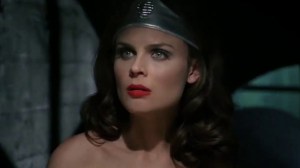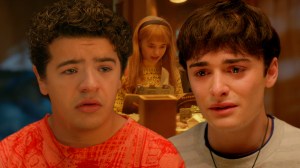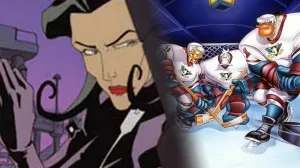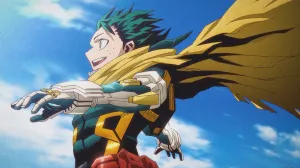
This weekend at New York Comic Con, Dark Horse is announcing two new series from writer Van Jensen and artists Pete Wood and Nate Powell. ComicBook.Com has an exclusive interview with all three creators discussing both Cryptocracy, a world-spanning conspiracy thriller, and Two Dead, a historical mystery about the murder-suicide of two Arkansas lawmen.
Videos by ComicBook.com
Check out the interview, art, and solicits below.

Cryptocracy
Van Jensen (W)
Pete Woods (A)
Spencer Cushing (Editor)
May 2016
They were the gunmen on the grassy knoll.
They conducted the Philadelphia Experiment.
They found the ship that crashed in Roswell—and its pilots.
They allowed the Japanese to attack Pearl Harbor.
They faked the moon landing.
For ages, they have worked in the shadows, controlling the fate of the world. But now, they are being hunted.

Two Dead
Van Jensen (W)
Nate Powell (A)
Spencer Cushing (Editor)
September 2016
On a snowy New Year’s Day, 1947, in Little Rock, Arkansas, Police Chief O. N. Martin gunned down his lieutenant, Jack Deubler, and then killed himself. The threads of crime, conspiracy, violence, racism, and madness that led to this tragic true-crime case of murder-suicide are retraced in Two Dead.
Chase Magnett for ComicBook.Com: This is a big announcement for with two original series being published in the next year. What compelled you to focus on writing and publishing some of your own concepts now?
Van Jensen: Thanks! It’s thrilling to be back at creator-owned comics for the first time in a few years. When I started writing for DC, I was still working full time as a magazine editor and didn’t have time for more comics work. But right about the time I started transitioning to just writing, Dark Horse and I started talking. I actually had two pitches from years before that I’d been itching to revisit, and it worked out that an editor took to the concepts.
I’ve grown a lot as a writer over the past few years, and now I’m getting to work on ideas that are very personal. It’s all just really exciting and energizing. I’ve never had as much fun making comics. Two Dead and Cryptocracy are two very different comics, but they’re both very much my interests and passions being put right onto the page.
Magnett: And what made Dark Horse the right publisher to bring these ideas to print?
Jensen: Dark Horse is one of the titans of the industry, a company I’d always hoped I’d work with eventually. But beyond that, Dark Horse has a clear tone, putting out books that are smart and scary and just the right kind of weird. That always resonated with me as a reader. Now, as a creator, I’m finding it a perfect fit.
Magnett: The shared theme between these two comics seems to be the nature of conspiracy. What is it about that concept that appeals to you as a writer?
Jensen: It’s all about knowledge as power. Information is incredibly valuable, but it must be wielded with great care. When that power is abused, it’s extremely damaging. And once damage begins, it spreads, actions and reactions rippling out across time and space.
In Two Dead, that’s the main focus, though it’s tinged through a perspective of mental illness and pervasive racism. Cryptocracy takes a much weirder, sci-fi look at conspiracy.
Magnett: Focusing on Cryptocracy, where did the premise for this series originate?
Jensen: I just saw one more in a long line of movies where the secret-cabal-in-control-of-the-world was the villain, and I thought, “Huh, what if we saw the story from their perspective?” Then it’s just a matter of pursuing trains of logic. Why would you choose to control world events from the shadows? What would be a real threat to you? What would life be like if you dominated everything, and nothing was left to chance?
I actually came up with the concept maybe six years ago. It’s gone through a few title changes since. “Cryptocracy” is a term used by conspiracy theorists to describe the shadowy rulers who secretly dominate the world.
Magnett: What about Cryptocracy most appealed to you (Pete Woods) when you first heard about it?
Pete Woods: Van and I were both involved with a big event at DC which is how we became introduced. At some point either in an email thread or on social media I had mentioned my fondness for weird conspiracy theories- aliens, illuminati, out of place artifacts, that sort of thing- and Van approached me with this idea.It sounded up my alley so he sent me the pitch he was developing at Dark Horse. I read it once and loved it. It wasn’t treated as a gimmick, but a thoughtful world full of rich, well rounded characters. I shared the pitch with my wife Rebecca and our fourteen year old daughter and they both loved it too. That was what sealed the deal for me.
Magnett: Conspiracy stories certainly aren’t new to the comics medium. What makes Cryptocracy stand out in your mind as something truly unique?
Jensen: Aside from Jason, the foul-mouthed bugbear? The perspective, definitely. This is a story from the point of view of the proverbial “they,” the dark figures that tin-foil-hat folks worry over. They are the Nine Families. Nothing happens unless by their design. Finally, we’re going to get to see their side of things.
Beyond that, this is the first time for fans to see Pete Woods on a creator-owned book, and he is turning in jaw-dropping pages. This is one of the biggest, craziest books you’ll see in 2016, and no matter what weirdness I throw Pete’s way, he hammers it out of the park.
Woods: There’s several things that set Cryptocracy apart from your typical conspiracy story. First and foremost is the focus on character. We’ve got some bizarre things happening around these people yet the core of the story isn’t the craziness but how the characters face these events and deal with the profound changes brought into their lives because of them. We’re also treating these ideas with love and respect. Conspiracy tales usually take one of two tacks. Either everything is dark and mysterious and information is doled out to the audience at an agonizingly slow pace or it’s treated satirically with an elbow to the ribs saying “look at the goofy things the tinfoil hat brigade believe.” While we do have elements of those things here and there, we’re not going down those well-worn paths. We approach crazy concepts in a matter of fact way and the characters have to deal with it as best they can.
Magnett: The narrative lends itself to a wide variety of settings, not only across the Earth, but across time. What kind of settings and scenes are you most looking forward to engaging in this world?
Woods: Where do I start? One of the great things about working on a book like this is that we can take the reader to places and situations that WE find fun and interesting. We’ve got secret bases, weird technology, cloistered halls, and wide open vistas. Van and I knocked out a little flashback story recently that takes place in the New Mexico desert during the late 1940’s which I’m looking forward to drawing quite a bit. All of it is fun and I think that’s coming through in the work we are doing.
Jensen: I’m a compulsive planner, so I actually created an entire false-history of the Earth. There’s a timeline hanging in my office that’s three 11×17 sheets taped end-to-end with tiny handwriting marking out global events. If anyone sees it, they’ll think I’m a crazy person.
Anyway…this story is huge. It encompasses the past, present and future of the world. There are going to be some key flashbacks to events that conspiracy theorists know well, but it also will take us to places on Earth that have been hidden from our eyes by the Nine Families. Like The Preserve. Oh, just wait till you see what’s secreted away inside The Preserve…
What do you think makes this premise visually compelling, something that works better in comics than another medium?
Woods: One of the advantages comics has over other visual mediums is that it’s more forgiving when it comes to suspension of disbelief. We’ve got Strange creatures, weird technology, and events that twist the fabric of reality itself. In comics you can make it all fit together and make sense to the readers’ eye.
Another huge advantage comics has is that the audience can stay with a scene and really step into the world. As a creator you can build a rich and detailed world and know your readers are going to be able to catch those details. Comics move at the audience’s pace, not so much the writer or artist’s so we have a responsibility to make it somewhere the reader wants to be.
Magnett: Moving on to Two Dead, how did you discover this little known historical anecdote? It’s not an easy topic to find and research, at least not on Google in one afternoon.
Jensen: Two Dead is inspired by a true story, about a very sudden and shocking burst of violence in Little Rock, Ark., in the late 1940s. It was a piece of history I stumbled across back in 2006 when I was a crime reporter at the newspaper in Little Rock.
Quick background on that job: First thing in the morning, I’d call the coroner and ask who got murdered overnight. Then I’d turn on the police scanner and wait for someone else to get shot so I could race to the crime scene and report on the story. It was a brutal job, and I saw some pretty horrific things that I wish I could forget.
But I also spent a lot of time just hanging out with cops and detectives, and one day someone randomly mentioned that the chief of detectives in the post WWII era was schizophrenic, thinking that evil forces were overtaking the city and conspiring against him.
That all just happened to coincide with rampant organized crime and a strictly segregated city. It was a fascinating time and place, vibrant, beautiful and deadly all at once, L.A. Confidential transplanted in the South.
Magnett: What about the story fascinated you enough that it not only stuck with you, but made you want to transform it into a comic of your own?
Jensen: There was a clear narrative to it, a story of tragedy and hope and fear and prejudice. There were great characters, each with his or her own aspirations and flaws. And the setting is just a singular time and place–one that happens to be largely unexplored in works of fiction.
It’s also compelling to me because it is a crime noir story that’s thematically pacifist. I think my favorite noirs–like The Third Man–are those that don’t shy away from the true cost of violence.
Honestly, the thing that gave me pause the most was that it is a true story. And while it’s far in the past, I’m always wary of sharing old, private pains in a public way. Which is why we decided to change some names and details, to not pry into the lives of those who survived it all.
Magnett: What about Two Dead made you (Nate Powell) want to get involved and collaborate on the series?
Nate Powell: Van approached me back in 2011 about the possibility of working together on this. I’d known him from his journalism work in my hometown of Little Rock, and we’d actually become familiar with each other independent of comics. So tying the knot with a creative project rooted in my hometown was a natural pick.
Magnett: This will be your first big project since beginning work on March. Has your experience working on another historical narrative influenced how you approach this sort of narrative?
I was expecting that to be the case, but in truth my work on Two Dead has largely been an opportunity to explore the story’s landscape out of my own memories and experiences, though removed by half a century. This hardwired familiarity has allowed me to focus more on the subjective and internal elements of the characters and their personal relationships to Little Rock.
Magnett: When doing work based in history, what kind of research do you engage in? How committed are you to showing the reality of a specific era and the elements involved?
Jensen: Like I said before, I’m compulsive. I have a thick folder of archival newspaper articles I pulled from microfiche, as well as lots of archival photos culled from various historical sources. I still have a few friends at the LRPD, and they’ve been great about helping me track down details. I’m still hoping to make a trip back to Little Rock soon, as there are a couple of things I haven’t found yet.
Also, I’m working with artist Nate Powell, who is obviously an incomparable talent, but he’s also skilled with capturing historical events through his work on the MARCH series of autobiographical graphic novels. And beyond that, Nate grew up in North Little Rock, so he knows that region as well as anyone. There is literally no one else out there who could’ve done this book.
Powell: As a journalist, Van has provided some great reference to use as a starting point. I definitely look in some local archives (and think back through my own family’s collective memories) for location reference, but most of my reference searches involve the mundane indicators: clothes, technology, and cars. (That’s definitely the same in March as well.) Beyond establishing a solid entry point for the reader to dwell in 1940’s Little Rock, I try not to sweat the accuracy too much– it doesn’t take much to turn a historical narrative into a dry, detail-oriented account, or to sap the joy out of the creative process. The reader gets it, and we can all dive into the story beyond its historical constraints.
Magnett: What do you think makes this premise visually compelling, something that works better in comics than another medium?
Powell: Two Dead is a perfect candidate for exploiting the comics medium. I’m naturally drawn to stories (both as a creator and as a reader) with truly ambiguous perspectives, unanswered questions, rich internal landscapes, and unreliable narrators. Van’s story unfolds gradually, revealing layers a bit like Haruki Murakami might– one of my favorite authors, but comics also allow a reader to exist in all components of a book at once, for reference, clarity, and exploring the advantage of repeating visual themes throughout. Comics employ an expressive immediacy and richness which, at its best moments, provides a window into a story’s core that’s difficult to attain elsewhere.
Magnett: For readers unfamiliar with your work, what do you think will make these two books stand out on comics shelves as the thing to check out in 2016?
Jensen: These two books both have heart. They’re very different, twisting stories filled with action and horror and humor. But ultimately they’re about the characters. Two Dead is the story of men who just want to fix a city, and how far they’ll go to achieve that end. Cryptocracy is the story of a man who thinks he has every single thing perfectly under control, only to finally be confronted with a mystery even he can’t untangle.
I’m putting everything I have creatively into both of them, and I’m collaborating with two of the top artists in the medium who are both turning in some of their greatest work. These books will be fun and thrilling, but they’ll also challenge and surprise you, I can promise that.








